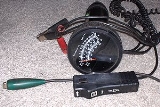
Ignition timing
Overview
Internal combustion engine
The internal combustion engine is an engine in which the combustion of a fuel occurs with an oxidizer in a combustion chamber. In an internal combustion engine, the expansion of the high-temperature and high -pressure gases produced by combustion apply direct force to some component of the engine...
(ICE), is the process of setting the angle relative to piston position and crankshaft angular velocity
Angular velocity
In physics, the angular velocity is a vector quantity which specifies the angular speed of an object and the axis about which the object is rotating. The SI unit of angular velocity is radians per second, although it may be measured in other units such as degrees per second, revolutions per...
that a spark
Spark
-Physical sparks:* Spark , a small glowing particle or ember* An electric spark, usually with a flash and a sharp noise-Computer science:* SPARK...
will occur in the combustion chamber near the end of the compression stroke. The need for timing the spark is because fuel does not completely burn the instant the spark fires, the combustion gasses take a period of time to expand, and the angular or rotational speed
Rotational speed
Rotational speed tells how many complete rotations there are per time unit. It is therefore a cyclic frequency, measured in hertz in the SI System...
of the engine can lengthen or shorten the time frame in which the burning and expansion should occur.

